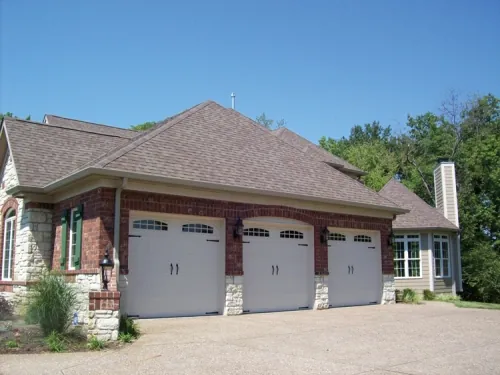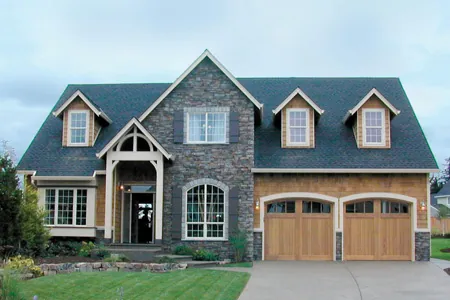 by Jennifer Jones
by Jennifer Jones
Many homeowners would agree that the garage is home to much more than the family car.

View this House Plan
View Other Luxury House Plans
Gardening and yard tools, sporting equipment, bicycles, muddy shoes, and hundreds of other odds and ends gather in a jumble, leaving just enough room to park the car in bad weather if lucky. This familiar situation prevents the garage space from being fully utilized by your family. Tackling the design of your garage and organizational system may take time now, but will certainly pay off in the end.
The first thing to look at when making the most of your garage space is to examine the garage doors. Most garage doors come in a variety of materials. Wood is most traditional, but metals, synthetics, and fiberglass are becoming more popular. These newer materials are cheaper, safer, and require far less maintenance. They can be insulated and most all are fire and pest resistant. Beyond the materials available, garage doors also come in a number of styles. It's best to choose the garage door that will be most functional for your space.
- Roller - Roller doors are the most popular style of garage door. The door is stored along the roller system when opened.
- Sectional Doors - Sectional doors are exactly like roller doors in look and action, but do not operate on rollers. Both roller and sectional doors are ideal for space saving, as they do not take up any extra space when open or closed.
- Up and Over Doors - Up and over doors are those that swing outward and up before sliding into its stored position. This style is classic but does require more space when opening and closing.
- Side-hinged - Side hinged doors are the simplest of all garage door styles. These are often double doors that close and lock in the middle. These doors need the most space to swing open and closed and as such, are often found in rural areas.

View this House Plan
View Other Ranch House Plans
Once you have determined the best door, take a look at the flooring material. The average garage has basic concrete floors. However, these floors can be damaged when exposed to certain household chemicals or even natural elements. By utilizing customized garage flooring, you can ensure the space is fully functional and may increase your home's value.
- Polyvinyl mat ? Polyvinyl mats are great floor covers for active garages. The rollout mats are easy to install, easy to clean, and come in a variety of colors and thicknesses.
- Tile ? Tiles hold up well against chemicals, dings, dents, and various means of traffic. These too can be customized in color.
- Floor coatings ? Floor coatings are often a high-grade epoxy that repels water and oil. These have an extensive lifespan and are easy to clean. These coatings can be combined with additives, like stone bits, that help create better traction.

View this House Plan
View Other Country House Plans
Once the doors and floors have been arranged, it is time to turn to the walls. The average garage is a collection of stacks placed haphazardly against every available vertical space. In order to organize your belongings and make the most of the space available, there are a few steps to take:
- Break into zones ? To organize your belongings most effectively, you must determine what will be happening in this space. Is there an area near the door that will be designated as a mud room or drop zone? Where will be the best place to store sporting equipment and lawn tools? Will you be parking two cars in the garage or is half the space a designated workshop? This is a good time to look for other storage opportunities. If you want to turn the garage into a workshop, can you place a shed in the yard to house seasonal items and toys that do not need to be in the garage?
- Sort stuff ? Before organizing all your belongings, it is imperative to have an accurate idea of what those belongings are. Begin by emptying the garage contents. As you go along, decide whether or not to keep, donate/sell, or toss each item. The items that you keep should be divided by category (example: sporting, house supplies, tools, etc). Be certain to return miscellaneous items to their proper home outside of the garage. Also bear in mind that some materials cannot be disposed of in the trash. Take proper precautions in tossing or recycling these items.
- Storage ? Once the sorting is complete, it is time to find a home for every item. Materials that are accessed regularly should be kept on open shelving that is within arms reach of all appropriate family members. Tall storage cabinets are great for storing seasonal items together and out of the way. Racks and pegboard are best for keeping bulky lawn items like rakes and trimmers handy but off the floor of the garage. Overhead storage and hooks and pulleys are other great ideas for storing large items that would not otherwise be able to reside in the garage.
Whatever system you use, it is important to designate a home for every item. Make it a habit to return it to its proper location and your garage will have little trouble staying tidy. In some cases it may be best to seek the help of a service professional who can design an extremely customized storage system. Whether you choose to organize yourself or seek professional advice, take your time and do the job thoroughly. With a little patience and effort, the garage will transform from an organizational nightmare to the space of your dreams!
Here are some related articles:
Save this article to:
back to top